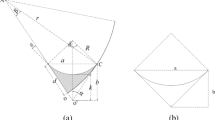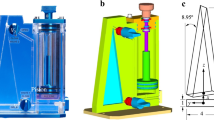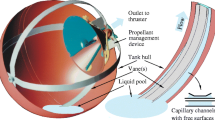Abstract
This paper describes the experiments on flow rate limitation in open capillary channel flow that were performed on board the International Space Station in 2011. Free surfaces (gas–liquid interfaces) of open capillary channels balance the pressure difference between the flow of the liquid in the channel and the ambient gas by changing their curvature in accordance with the Young-Laplace equation. A critical flow rate of the liquid in the channel is exceeded when the curvature of the free surface is no longer able to balance the pressure difference and, consequently, the free surface collapses and gas is ingested into the liquid. This phenomenon was observed using the set-up described herein and critical flow rates are presented for steady flow over a range of channel lengths in three different cross-sectional geometries (parallel plates, groove, and wedge). All channel shapes displayed decreasing critical flow rates for increasing channel lengths. Bubble ingestion frequencies and bubble volumes are presented for gas ingestion at supercritical flow rates in the groove channel and in the wedge channel. At flow rates above the critical flow rate, bubble ingestion frequency appears to depend on the flow rate in a linear fashion, while bubble volume remains more or less constant. The performed experiments yield vast data sets on flow rate limitation in capillary channel flow in microgravity and can be utilised to validate numerical and analytical methods.
















Similar content being viewed by others
Notes
\({Re} = \bar{u}_0 D_h \nu^{-1},\) where \(\bar{u}_0\) is the mean velocity at the inlet of the TC and ν is the kinematic viscosity of the liquid. D h is the hydraulic diameter with D h = 4A 0/P and P is the wetted perimeter.
References
Brakke KA (1992) The surface evolver. Exp Math 1(2):141–165
Dreyer ME, Rosendahl U, Rath HJ (1998) Experimental investigation on flow rate limitations in open capillary flow. In: 34th AIAA/ASME/SAE/ASEE Joint Propulsion Conference, AIAA 98-3165
Grah A, Dreyer ME (2010) Dynamic stability analysis for capillary channel flow: one-dimensional and three-dimensional computations and the equivalent steady state technique. Phys Fluids 22(1):1–11
Grah A, Haake D, Rosendahl U, Klatte J, Dreyer ME (2008) Stability limits of unsteady open capillary channel flow. J Fluid Mech 600:271–289
Haake D, Klatte J, Grah A, Dreyer ME (2010) Flow rate limitation of steady convective dominated open capillary channel flows through a groove. Microgravity Sci Technol 22(2):129–138
Jaekle DE (1991) Propellant management device conceptual design and analysis: Vanes. In: 27th AIAA/SAE/ASME/ASEE Joint Propulsion Conference, AIAA 91-2172
Klatte J (2011) Capillary flow and collapse in wedge-shaped channels. PhD thesis, Universitaet Bremen
Klatte J, Haake D, Weislogel MM, Dreyer ME (2008) A fast numerical procedure for steady capillary flow in open channels. Acta Mech 201(1-4):269–276
Melin J, van der Wijngaart W, Stemme G (2005) Behaviour and design considerations for continuous flow closed-open-closed liquid microchannels. Lab Chip 5:682–686
Rosendahl U, Dreyer ME (2007) Design and performance of an experiment for the investigation of open capillary channel flows. Exp Fluids 42(5):683–696
Rosendahl U, Ohlhoff A, Dreyer ME, Rath HJ (2002) Investigation of forced liquid flows in open capillary channels. Microgravity Sci Technol 13(4):53–59
Rosendahl U, Ohlhoff A, Dreyer ME (2004) Choked flows in open capillary channels: theory, experiment and computations. J Fluid Mech 518:187–214
Rosendahl U, Grah A, Dreyer ME (2010) Convective dominated flows in open capillary channels. Phys Fluids 22(052102):1–13
Salim A, Colin C, Grah A, Dreyer ME (2010) Laminar bubbly flow in an open capillary channel in microgravity. Int J Multiph Flow 36(9):707–719
Spivey RA, Sheredy WA, Flores G (2008) An overview of the Microgravity Science Glovebox (MSG) facility, and the gravity-dependent phenomena research performed in the MSG on the International Space Station (ISS). In: 46th AIAA aerospace sciences meeting, AIAA-2008-0812
Weislogel MM, Thomas EA, Graf JC (2009) A novel device addressing design challenges for passive fluid phase separations aboard spacecraft. Microgravity Sci Technol 21(3):257–268
Zhao B, Moore JS, Beebe DJ (2001) Surface-directed liquid flow inside microchannels. Science 291(5506):1023–1026
Acknowledgments
The authors would like to acknowledge the support provided by the NASA employees at Marshall Space Flight Centre and thank especially the MSG team. We thank NASA astronauts Scott Kelly, Catherine Coleman, and Mike Fossom, who installed and removed the experiment hardware on board the ISS. We also acknowledge the technical staff at Astrium for manufacturing the experiment hardware and for technical support during the experiments. The German research team was selected for award in NASA Research Announcement NRA-94-OLMSA-05 and is currently supported financially by the German Federal Ministry of Economics and Technology (BMWi) via the German Aerospace Center (DLR) under grant number 50WM0535/0845/1145. The U.S. research team was selected for award in NASA Research Announcement Microgravity Fluid Physics: Research and Flight Experiment Opportunities (NRA-98-HEDS-03) and is currently supported in part under NASA cooperative agreement NNX12AO47A.
Author information
Authors and Affiliations
Corresponding author
Additional information
Dedicated to Wade H. Stevens († 2011), CCF Operations Lead at NASA
Rights and permissions
About this article
Cite this article
Canfield, P.J., Bronowicki, P.M., Chen, Y. et al. The capillary channel flow experiments on the International Space Station: experiment set-up and first results. Exp Fluids 54, 1519 (2013). https://doi.org/10.1007/s00348-013-1519-1
Received:
Revised:
Accepted:
Published:
DOI: https://doi.org/10.1007/s00348-013-1519-1




